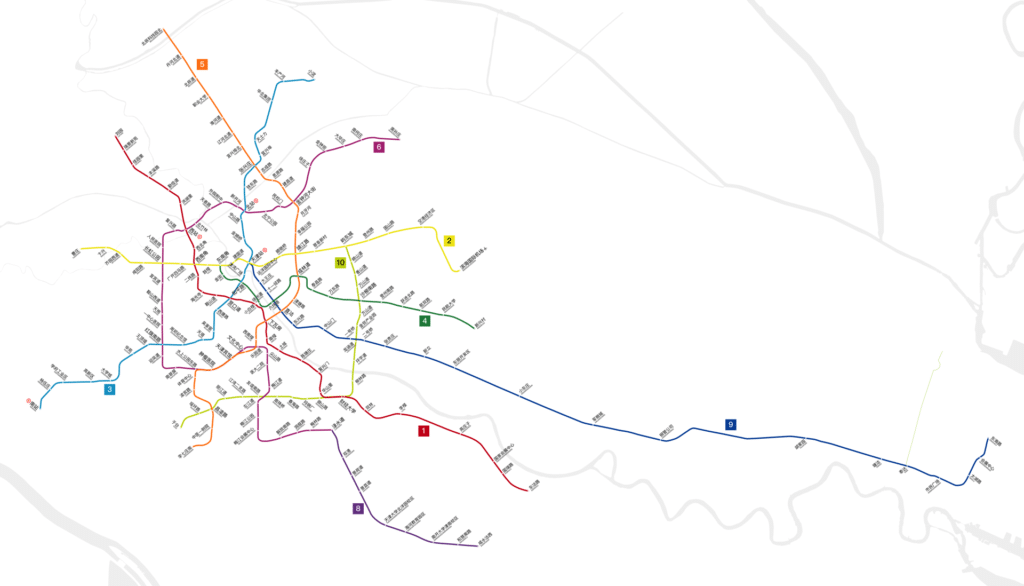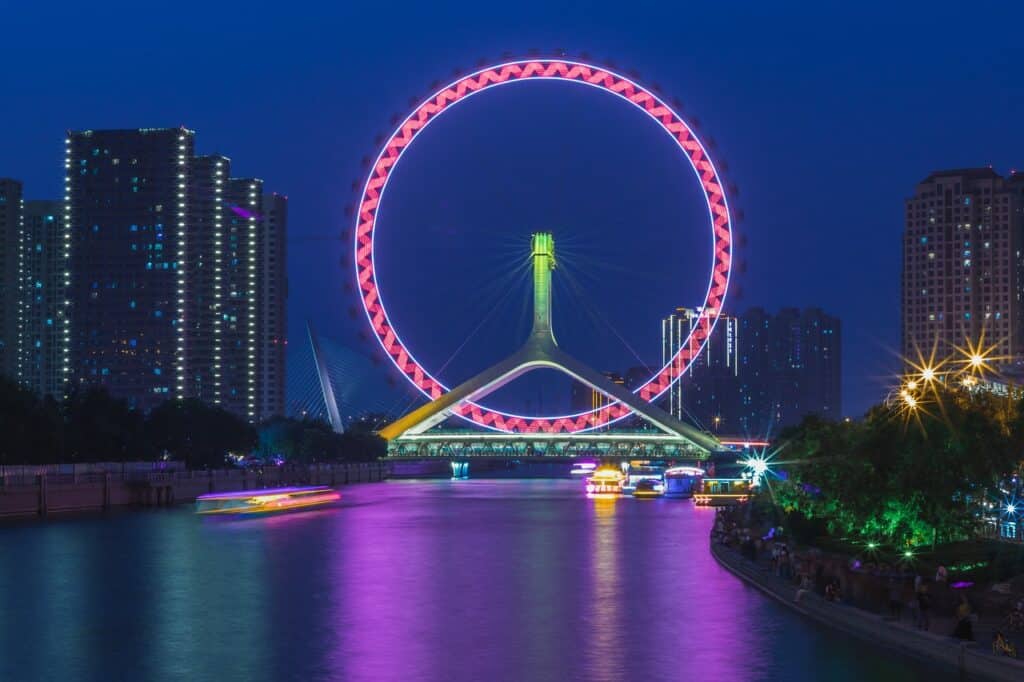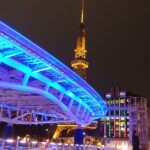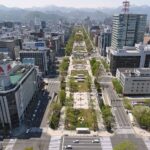Tianjin is a significant Chinese city with a well-developed public transportation network that features buses, a cutting-edge metro, trams, cabs, and ferries. More than 296 kilometers of track and more than 200 stations make up the Tianjin Metro, a rapid transit system. Over a century after it was first introduced, China’s tram network remains a popular mode of public transportation. Taxis and the city’s many buses are both affordable and plentiful. Shorter trips, such as crossing the Hai River, can also be made via ferry. Tianjin’s public transportation system is both convenient and inexpensive.
Metro in Tianjin: Basic Information
Tianjin’s metro is a cutting-edge, time-saving method of urban transportation. The entire network is longer than 296 kilometers, with nine lines and more than 200 stations. The system’s user-friendliness, along with the city’s well-developed bus and taxi infrastructure, makes it a practical means of transportation. It’s also linked to the Beijing subway, so you can go around the city with ease. Visitors and locals alike can ride any line, and tickets can be purchased from automated kiosks at each station. Tianjin’s metro provides a convenient way to see the city and its surroundings.
The lines of the Tianjin subway system
The first line of the Tianjin subway system extends from the city’s northwest to its southeast. It has a total length of 42.22 kilometres and 32 stations (27 of which are operational at present). The original Tianjin Metro line opened in 1976, but as part of a system-wide modernization effort in 2001, it was shut down and rebuilt.
The Tianjin Metro Line 2, which connects the western and eastern parts of the city, is 27.1 kilometers long and features 20 stops. All stations are underground, with the exception of Caozhuang, which is on the surface. In May 2011, one of the TBMs got trapped after a section of tunnel west of the Tianjin railway station collapsed due to flooding from the Hai River. Because of the high cost of rescuing the stuck TBM, it was decided to leave it where it was and dig a new tunnel around it.
The Tianjin Metro Line 3 connects the city’s northeast and southwest. Opening day was October 2012. There are a total of 26 stations along the 33.7-kilometer line, 8 of which are elevated and the rest are underground.
Line 4 service began on the Dongnanjiao-Xinxingcun segment in the south.
The Tianjin Metro’s Line 5 is a semicircular line that travels from the city’s northwest to its southwest. There are 28 stops along its 34.8-kilometer length. Half of Beichenkejiyuanbei lies beneath the surface. Liqizhuangnan performs adequately. There are no surface-level stations. Trains on this line are B-sized and have six cars. Line 5 and Line 6 make a circle that encircles Tianjin.
The Tianjin Metro’s Route 6 is a half-circle rapid transit route that travels from the city’s north-east to its south-east. The present length of the line is 42.6 kilometers, and it serves 38 stations. The line now operates with B-size trains that have six cars, although the platform is long enough to accommodate trains with eight cars should demand increase. Connecting Line 6 and Line 5 will result in a loop around Tianjin.
The Tianjin Metro Line 8 connects the city’s northwest and southeast via rapid transit. Line 8, formerly known as Line 6 Phase 2, opened its southern Phase I segment. There are now 9 stops along its 13.4-kilometer length. Type A, six-car GoA4 autonomous trains are being used for the first time on a Tianjin metro route.
Tianjin’s Metro has a high-speed route called Route 9. Connecting Tianjin’s urban core to Binhai New Area, a newly developed section of the city that falls under the purview of Tianjin Municipality, the line stretches for 52.8 kilometers and has 21 stations. The trip takes around an hour one way.
Map of Tianjin Metro 2024: Free Download in PDF

Click and download the map of Tianjin’s underground system for 2024
The Tianjin Metro 2024 Map depicts the whole network of subways and buses in the city. It’s easy to plan and navigate your trip with the help of this PDF guide, which is available for free download and provides thorough information about each metro station and connection. The map also features detailed information on how to get around the city via bus, trolley, ferry, and more. Visitors to Tianjin will feel more at ease exploring the city with the help of the Metro Map 2024.
Public transport tickets in Tianjin: actual prices
The most frequently purchased ticket is the three-day, thirty-yuan transit pass. You may take advantage of the entire public transit system with this ticket. The package also features savings at a number of local attractions.
A one-day ticket for public transportation can be purchased for 5 yuan. This ticket can be used on any kind of public transportation for a single day. It also features savings at local landmarks.
If you’re just in town for a short time, the Tianjin Tourist Card is a great way to save money and time. The card is available for 50 yuan and is good for three days. It’s valid on all types of public transit and comes with discounts to several attractions.
The monthly transit pass is a fantastic choice for individuals who will be in Tianjin for an extended period of time. The permit is good for one month and costs 120 yuan. It’s valid on all types of public transit and comes with discounts to several attractions.
The best choice for travellers staying in Tianjin for three days is to purchase a Tianjin Tourist Card. It’s easy to use, affordable, and comes with discounts to many attractions. You can make the most of your time in Tianjin by using this card to navigate around the city and access its many attractions.
Schedules of Tianjin Metro system
The Tianjin Metro system operates Monday through Friday from 5:30 a.m. to 11:30 p.m. and on Saturday and Sunday from 6:00 a.m. to 11:30 p.m. During rush hours, trains normally arrive every 5 minutes, whereas during off-peak times, they arrive every 10 minutes. There are presently over 80 stations spread out over the city, and the system is still growing. The night bus service, which runs from 11:30pm to 5:30am, is another useful feature of the Tianjin Metro. It’s a great way to see the sights without breaking the bank or wasting time.
What Are Other Options for Public Transportation in Tianjin?
The metro isn’t the only public transportation option in Tianjin, either. Numerous bus and trolley bus lines, as well as ferry services, link the city to its surrounding municipalities and provinces. Light rail and trams also provide easy and comfortable transportation across Tianjin for tourists. There are taxis all over the city, and you can use your phone to hail one using any of a number of apps. Using any of these methods, you can get around Tianjin quickly and cheaply.
how does public bus transportation work in Tianjin?
The public bus system in Tianjin, a large city in China, is among the best in the country. The city’s bus system is comprehensive, serving all of downtown and several of the surrounding neighborhoods. Regular and express bus lines number in the hundreds, making intercity travel a breeze.
The Tianjin Public Transport Group is in charge of the city’s bus system. Each bus has a/c and comfy seats for your ride. Depending on the distance traveled, fares might be anything from 1 to 3 RMB. Passengers have the option of paying with cash or a preloaded transit card. The card can be purchased at any major station and loaded with as much money as is needed for future rides.
The 101, 102, 103, 104, and 105 bus routes are the most popular in Tianjin. These lines serve the entire city and are especially convenient for navigating the downtown area. The 59, 66, and 75 are also significant lines since they connect downtown and the suburbs, while the 902 gets you to the airport.
Tianjin has both normal bus lines and fast bus lines. These buses travel quickly to locations outside of the city, as they use major highways. Express buses typically cost more than standard buses, but they can help passengers get where they’re going faster.
How do the public TRAINS work in Tianjin?
Tianjin’s train network includes express, intercity, and metro lines. High-speed trains, sometimes referred to as “bullet trains,” are the quickest option for getting from Tianjin to other Chinese cities. These trains can go as fast as 300 km/h, getting passengers where they need to go in a fraction of the time it would take a car. Even if they’re a little slower, intercity trains are nevertheless a pleasant method to get from one place to another. These trains have a number of different class configurations, from first to second to business. Finally, the city’s subway trains are a fantastic way to go around. These trains are quick, trustworthy, and reasonably priced.
Tianjin has excellent rail links to the cities in its vicinity. You may take a high-speed rail to get to any of China’s main cities, including Beijing, Shanghai, and Guangzhou. Qinhuangdao, Shijiazhuang, and Dalian are only a few of the cities that can be reached by intercity train. In addition, places outside of China, such as Pyongyang in North Korea and Ulan Bator in Mongolia, are accessible via high-speed train.
From Tianjin Binhai International Airport (TSN) To The City Center With Public Transport
The city’s international airport, Tianjin Binhai International Airport, is only 25 kilometers from the heart of the city, in the Tianjin Binhai New Area. Several modes of public transportation make the journey from the airport to the heart of the city quick and stress-free.
Taking the Airport Express Train is the quickest option for getting from the airport to the heart of the city. It takes about 20 minutes and 25 RMBs per person to take this train from the airport to Tianjin Railway Station. To get to the heart of the city from Tianjin Railway Station, take Line 2 of the Tianjin Metro.
If you’re seeking a cheap means of transportation to and from the airport, the Airport Express Bus is a viable alternative. The bus leaves the airport every 20 minutes towards the city center, and the fare is only 16 RMBs. The trip into the heart of the city should take about forty minutes.
How do I spend a weekend in Tianjin?
Tianjin, China, is a bustling metropolis that provides visitors with a one-of-a-kind adventure. There is a lot to see and do in this city, whether you’ve been there before or not. Here is a three-day itinerary for Tianjin that places an emphasis on off-the-beaten-path activities, excellent restaurants that locals recommend, and a lively nightlife.
Friday: stay in the city center
- A visit to Ancient Culture Street is a great way to kick off the day. Anyone visiting Tianjin for the first time should definitely check out this street. Here you may experience authentic local cuisine while learning about historic Chinese architecture. The Drum Tower is a 600-year-old structure that houses a massive drum that is played every morning and night.
- The trip to the Porcelain House follows lunch. The Porcelain House, right in the middle of town, is an absolutely gorgeous structure that was constructed out of nothing but porcelain. It’s an excellent spot for photography and architectural appreciation.
- Try out one of the restaurants the locals recommend for supper. Tianjin’s cuisine is as distinct as any other in China. Stop by a local restaurant and order some of the house specialties like braised pork or steamed dumplings.
- The Tianjin Eye is a great place to end the day. Amazing nighttime views of the city may be seen from this wheel, which is unique in that it is erected atop a bridge.
Saturday: go around the city
- The next morning, head to the Haihe River to begin your adventure. This river runs through the heart of the city and is an absolute must-see for any tourist. Walk along the river’s edge and take in the spectacular sights of the city below.
- Proceed to China’s Great Wall next. One of the best-maintained parts of the wall is the piece close to Tianjin. Visit one of the city’s many shopping centers for some retail therapy after a day of sightseeing.
- ‘Duck Blood Soup’ is a popular dish in the area, and it’s a spicy soup cooked with duck blood and duck flesh. You can even eat the native grilled street cuisine if you’re feeling adventurous.
- Spend the evening at one of Tianjin’s many exciting nightclubs or pubs. The nightlife in this city is legendary, and it’s a fantastic venue to keep the party going until dawn.
Sunday: have some fun
- Visit the city’s ancient temples on your last day there. Tianjin is home to some of the most well-preserved Buddhist temples in China. These temples are excellent resources for learning about Chinese history and culture.
- Stop by the Tianjin Water Park thereafter. Featuring a variety of attractions like wave pools and water slides, this park is among the largest in China.
- The Tianjin Night Market is a great place to grab some food. Noodles and dumplings are only two of the local specialties that may be tried here.
- The Tianjin Opera House should be your final stop. Seeing a performance of Chinese opera in this magnificent hall is a wonderful introduction to the country’s rich cultural heritage.
There is something for everyone in this comprehensive three-day plan for Tianjin. Tianjin has everything: vibrant nightlife, delicious food, and interesting cultural experiences.
What other metro systems are nearby in Tianjin?
The most notable one is the Beijing Subway, which is one of the busiest and most comprehensive metro systems in the world, located just 120 kilometers away. Another nearby system is the Dalian Metro in Liaoning province. There is also the Jinan Metro in Shandong province, which is a relatively new system but has been expanding rapidly. These metro systems provide convenient and efficient transportation options for the residents and visitors of Tianjin.
WOULD YOU LIKE TO SEE A VIDEO TOUR GUIDE ABOUT PUBLIC TRANSPORTATION IN TIANJIN?
Summary of our tour guide for Tianjin
Over the previous five years, I’ve had plenty of practice using Tianjin’s public transit system as a resident. It is dependable, cheap, and easy to use, at least in my experience. Buses and the metro, which are both relatively easy to navigate, are the main modes of public transportation in the city. I can attest to the dependability and high frequency of both thanks to my extensive use of both. In addition to the city’s sophisticated infrastructure, its metro system is extremely extensive. I’ve found it to be a convenient and inexpensive mode of transportation. Public transit in Tianjin has played a significant role in my daily life, and I have generally been pleased with it.
Top 5 FAQs and answers about Tianjin public transport?
- First, how many and what kinds of public transportation are there?
- Buses, subways, trams, taxis, and ferries are just some of the public transportation choices available in Tianjin. Over 500 different bus lines make the city’s public bus system one of the most popular ways to get around. The subway system is also highly practical, serving most of the city with its 8 lines. Although buses and subways get more ridership overall, trams and cabs are also options. Last but not least, Tianjin connects to the surrounding ports of Tanggu and Binhai via several ferry routes.
- What are my options for paying for bus fares?
- The Tianjin Public Transport Card is the most common method of paying for rides on the city’s public transportation system. To ride buses, subways, and trams, you can load money into this contactless smart card. It can be used to buy ferry rides as well. You can save money on your fare by purchasing this card at any of the city’s transportation hubs.
- Thirdly, when can I expect public transportation to be available?
- Tianjin’s public transportation services have varying hours of operation. The subway is open from 6:00 AM to 11:00 PM, while buses run from 5:00 AM to 11:00 PM. From 6 am to 12 am, you can ride the trams and cabs, and from 7 am to 9 pm, you can take the ferries.
- When taking public transportation, do you feel secure?
- Tianjin’s public transportation system is rather secure, yet it’s still smart to exercise common sense. You should not utilize public transportation late at night if possible, and you should be careful with your possessions at all times. Pickpockets are another threat that might target naive tourists.
- Is a visitor’s pass offered?
- Visitors to Tianjin can get a tourist pass, yes. The Tianjin Tourist Pass provides five days of unrestricted rides on the city’s public transportation system. The pass, which can be acquired at any of the city’s transportation hubs, is a convenient method to go around town without having to track down and pay for multiple separate fares.
Useful links







